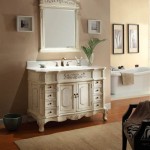Are Porcelain Bathroom Sinks Durable?
Porcelain bathroom sinks have been a mainstay in residential and commercial restrooms for decades. Their classic aesthetic, relatively low cost, and ease of cleaning contribute to their enduring popularity. However, a fundamental question persists for homeowners and builders alike: are porcelain bathroom sinks truly durable enough for the rigors of daily use?
The durability of a porcelain bathroom sink is a nuanced topic, dependent on several key factors including the manufacturing process, the quality of the materials used, the frequency and type of use, and the level of maintenance provided. Simply stating that porcelain sinks are unilaterally “durable” or “not durable” is an oversimplification. A comprehensive evaluation requires a deeper understanding of the material itself and the potential vulnerabilities that may compromise its structural integrity.
Porcelain, in the context of bathroom sinks, is typically a ceramic material composed of clay, kaolin, feldspar, and silica. These raw materials are combined and fired at extremely high temperatures, resulting in a hard, non-porous surface. This firing process vitrifies the material, meaning it transforms into a glass-like substance. The vitrification process is crucial to the durability of the final product.
It’s also important to understand the relationship between porcelain and vitreous china. Vitreous china is essentially a porcelain enamel applied to a ceramic base, such as fireclay. While often used interchangeably with "porcelain," vitreous china offers added strength and resistance to staining and scratching. The application of this enamel reinforces the surface and contributes to greater overall durability. Therefore, sinks described as ‘vitreous china’ often exhibit slightly improved performance compared to basic porcelain.
Material Composition and Firing Temperature
The inherent durability of porcelain is directly linked to its composition and the temperatures at which it is fired. Higher firing temperatures generally produce a denser, more vitrified material. This increased density translates to greater resistance to impact, chipping, and cracking. Sinks manufactured using lower-quality materials or inadequate firing processes are inherently more vulnerable to damage.
Differences in the proportions of raw materials used can also affect the final product's strength. For instance, a higher proportion of feldspar can contribute to a more durable, glass-like finish. Conversely, an excess of clay might result in a more porous and potentially weaker structure. Manufacturers often keep their specific recipes confidential, making it difficult for consumers to discern the exact composition of a particular sink. However, paying attention to the manufacturer’s reputation and warranty information can provide some indication of the quality of materials and firing processes.
The presence of any imperfections in the initial mixture or during the firing process can also create weak points in the finished product. These imperfections, such as air bubbles or uneven density, can compromise the sink’s structural integrity and make it more susceptible to damage. Rigorous quality control measures during manufacturing are essential to minimize the risk of such defects.
Consumers should be aware that even seemingly identical porcelain sinks can exhibit variations in durability based on these subtle differences in composition and manufacturing. Choosing a reputable brand with a history of producing high-quality products is a prudent approach to mitigating this risk. Furthermore, carefully inspecting the sink for any visible imperfections before installation is highly recommended.
Resistance to Scratches, Stains, and Chemicals
One of the primary advantages of porcelain and vitreous china sinks is their inherent resistance to staining and scratches. The smooth, non-porous surface prevents liquids and dirt from penetrating the material, making cleaning relatively easy. However, this resistance is not absolute. Abrasive cleaning agents and harsh chemicals can, over time, dull the finish and potentially cause micro-scratches that accumulate and make the surface appear dingy.
While porcelain is generally resistant to most common household chemicals, prolonged exposure to highly acidic or alkaline substances can etch the surface. This etching process can create a permanent dullness or discoloration. It's crucial to use cleaning products specifically designed for porcelain or vitreous china and to avoid harsh chemicals like bleach or concentrated ammonia.
The hardness of the surface also plays a role in scratch resistance. While porcelain is relatively hard, it is still susceptible to scratches from sharp objects or abrasive materials. Jewelry, metal tools, and harsh scouring pads can all cause damage. To maintain the appearance of a porcelain sink, it’s best to avoid placing sharp objects directly on the surface and to use non-abrasive cleaning methods. Using a soft cloth or sponge with a mild detergent is typically sufficient for routine cleaning.
The ability of a porcelain sink to resist staining is also affected by the quality of the glaze or enamel applied. A well-applied, high-quality glaze will provide a smoother, more impermeable surface than a poorly applied or low-quality glaze. This difference in glaze quality directly impacts the sink’s long-term resistance to staining and discoloration. Regular cleaning and proper maintenance are essential for preserving the appearance of the sink over time.
Furthermore, the color of the porcelain can impact its perceived resistance to staining. Lighter-colored sinks, such as white or ivory, tend to show stains more readily than darker-colored sinks. This does not necessarily mean that lighter-colored sinks are inherently less durable, but rather that stains are simply more visible on their surface. Regular cleaning is particularly important for lighter-colored sinks to prevent staining from becoming permanent.
Impact Resistance and Potential for Chipping/Cracking
Perhaps the most significant vulnerability of porcelain bathroom sinks is their susceptibility to chipping and cracking from impact. Despite being fired at high temperatures, porcelain retains a degree of brittleness. A sharp blow from a heavy object, such as a dropped bottle or tool, can easily cause a chip or crack in the surface. The severity of the damage depends on the force of the impact and the location on the sink.
The areas around the rim and the drain are particularly vulnerable to chipping and cracking. These areas are often thinner and more exposed than other parts of the sink. Dropping an object directly onto the rim is highly likely to cause damage. Similarly, overtightening plumbing fixtures during installation can put undue stress on the drain area, leading to cracks.
Once a chip or crack occurs, it can be difficult to repair inconspicuously. While repair kits are available, they often do not perfectly match the original color and texture of the porcelain. Furthermore, the repair may not be as durable as the original surface and may be prone to further damage. In some cases, the only viable solution is to replace the entire sink.
To mitigate the risk of impact damage, care should be taken to avoid dropping heavy objects onto the sink. Installing a sink with a thicker rim or a reinforced design can also provide added protection. Furthermore, ensuring that plumbing fixtures are properly installed and not overtightened is crucial for preventing stress cracks. Regularly inspecting the sink for any signs of hairline cracks can also help to identify potential problems early on.
Choosing a sink with a matte finish may also help to disguise minor scratches or chips compared to a glossy finish. While a matte finish may not be as aesthetically appealing to some, it can offer a more forgiving surface that is less likely to show minor imperfections. Ultimately, preventing impact damage is the most effective way to ensure the longevity of a porcelain bathroom sink.
In conclusion, the durability of a porcelain bathroom sink is a complex issue influenced by numerous factors. While porcelain offers advantages in terms of stain resistance and ease of cleaning, its inherent brittleness makes it vulnerable to chipping and cracking from impact. By understanding the material's properties and taking appropriate precautions, consumers can maximize the lifespan and maintain the appearance of their porcelain bathroom sinks.

The Beauty And Durability Of Ceramic Bathroom Sinks A Comprehensive Guide
Bathroom Sink Material Guide Signature Hardware

Porcelain Vs Ceramic Sink Which One Is Better My Interior Palace
Types Of Modern Bathroom Sink Materials Glass Porcelain Stone
Bathroom Sink Material Guide Signature Hardware

The Pros Cons Of Ceramic Sinks
Bathroom Sink Material Guide Signature Hardware
Bathroom Sink Material Guide Signature Hardware

Why Is Porcelain The Best Material For Your Kitchen Sink Lx Hausys

Ceramic Porcelain Sink Repair True Value
Related Posts







